Abstract
We have shown that nontransformed mammalian cells arrest early in the G1 phase of the cell cycle when treated with exceedingly low concentrations of the nonspecific kinase inhibitor staurosporine, whereas transformed cells continue to progress through the cell cycle. We have now treated normal or transformed human skin fibroblasts with four other kinase inhibitors. Three of these inhibitors are highly specific: KT5720 inhibits cAMP-dependent protein kinase, KT5823 inhibits cGMP-dependent protein kinase, and KT5926 inhibits myosin light-chain kinase. The fourth inhibitor K252b has a moderate specificity for protein kinase C but also inhibits the three kinases just mentioned. We have found that these inhibitors reversibly arrest normal human skin fibroblasts at different times in the G1 phase but do not affect the cell cycle progression of transformed cells. The times of arrest within the G1 phase can be divided into two categories. Two of the inhibitors, KT5926 and K252b, act at an early time that is approximately 4 h after the transition from G0 to G1. The cAMP- and cGMP-dependent protein kinase inhibitors KT5720 and KT5823 arrest cells at a later time that is approximately 6 h after the G0/G1 boundary. These data indicate that there are multiple kinase-mediated phosphorylations of different substrates that are essential for the progression of normal cells, but not transformed cells, through the G1 phase. These inhibitors provide us with a set of biochemical probes that should be invaluable in the study of the function of kinases during G1 phase progression of normal cells.
Full text
PDF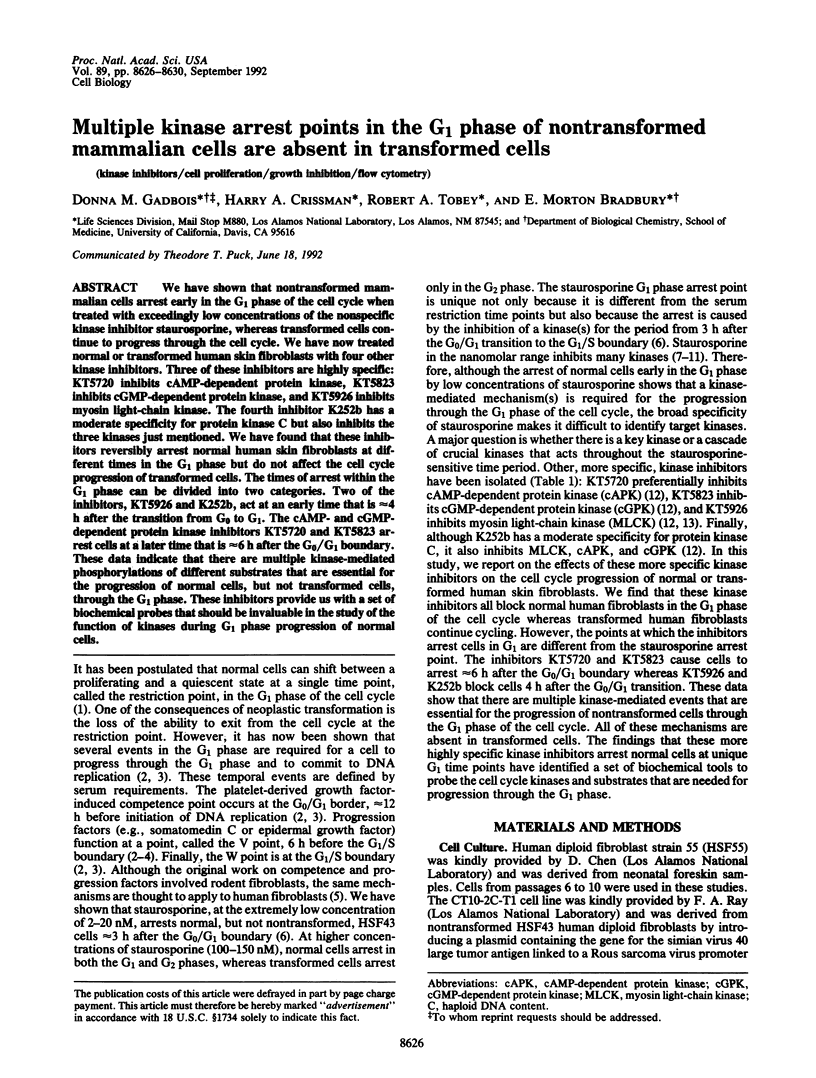
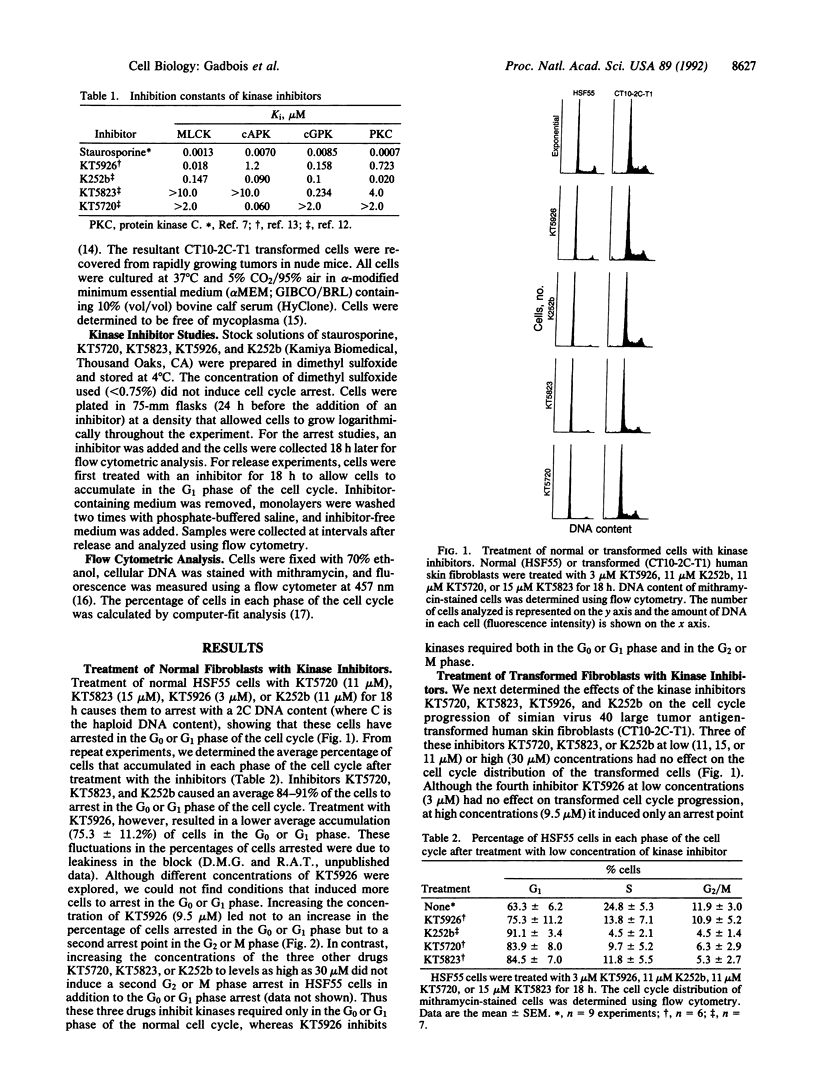
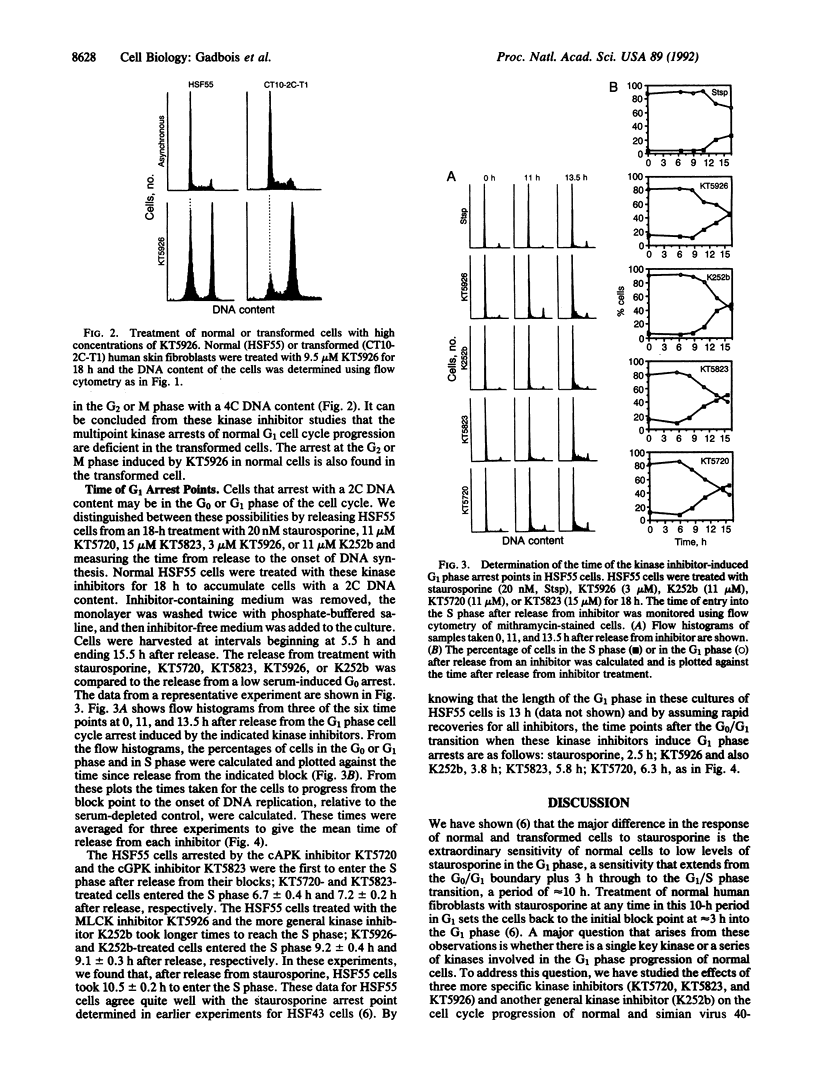
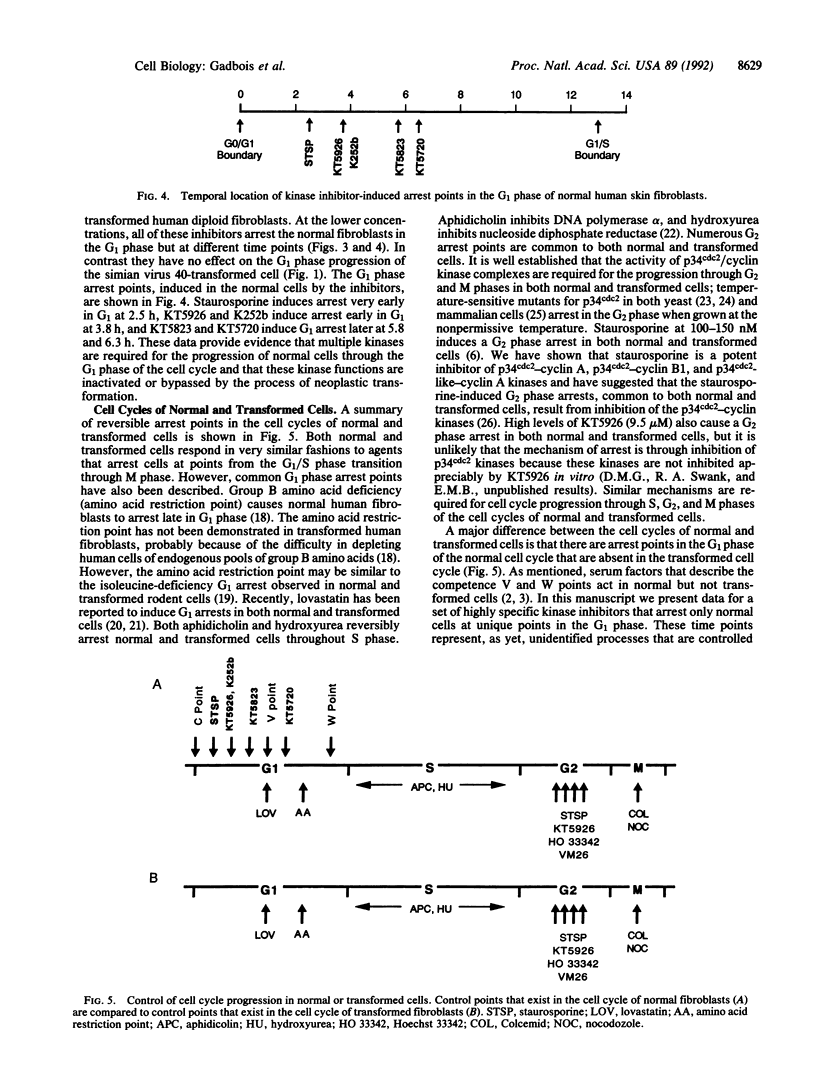
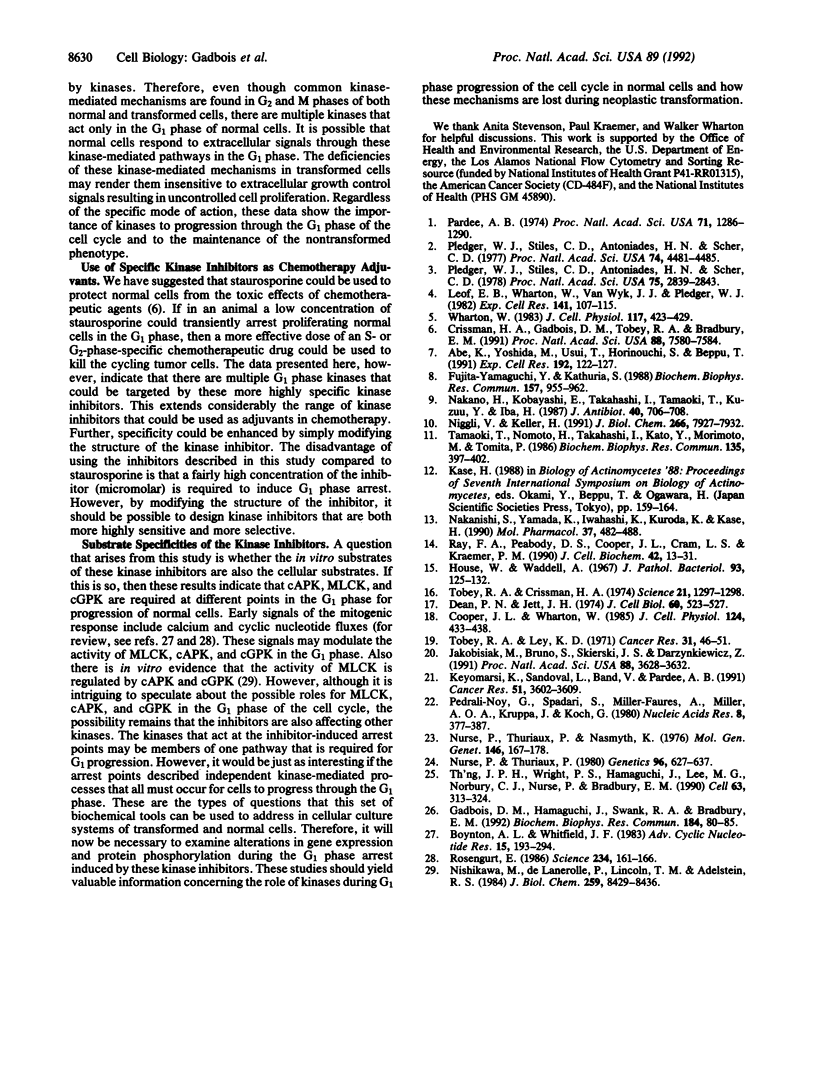
Selected References
These references are in PubMed. This may not be the complete list of references from this article.
- Abe K., Yoshida M., Usui T., Horinouchi S., Beppu T. Highly synchronous culture of fibroblasts from G2 block caused by staurosporine, a potent inhibitor of protein kinases. Exp Cell Res. 1991 Jan;192(1):122–127. doi: 10.1016/0014-4827(91)90166-r. [DOI] [PubMed] [Google Scholar]
- Cooper J. L., Wharton W. Late G1 amino acid restriction point in human dermal fibroblasts. J Cell Physiol. 1985 Sep;124(3):433–438. doi: 10.1002/jcp.1041240311. [DOI] [PubMed] [Google Scholar]
- Crissman H. A., Gadbois D. M., Tobey R. A., Bradbury E. M. Transformed mammalian cells are deficient in kinase-mediated control of progression through the G1 phase of the cell cycle. Proc Natl Acad Sci U S A. 1991 Sep 1;88(17):7580–7584. doi: 10.1073/pnas.88.17.7580. [DOI] [PMC free article] [PubMed] [Google Scholar]
- Crissman H. A., Tobey R. A. Cell-cycle analysis in 20 minutes. Science. 1974 Jun 21;184(4143):1297–1298. doi: 10.1126/science.184.4143.1297. [DOI] [PubMed] [Google Scholar]
- Dean P. N., Jett J. H. Mathematical analysis of DNA distributions derived from flow microfluorometry. J Cell Biol. 1974 Feb;60(2):523–527. doi: 10.1083/jcb.60.2.523. [DOI] [PMC free article] [PubMed] [Google Scholar]
- Fujita-Yamaguchi Y., Kathuria S. Characterization of receptor tyrosine-specific protein kinases by the use of inhibitors. Staurosporine is a 100-times more potent inhibitor of insulin receptor than IGF-I receptor. Biochem Biophys Res Commun. 1988 Dec 30;157(3):955–962. doi: 10.1016/s0006-291x(88)80967-7. [DOI] [PubMed] [Google Scholar]
- Gadbois D. M., Hamaguchi J. R., Swank R. A., Bradbury E. M. Staurosporine is a potent inhibitor of p34cdc2 and p34cdc2-like kinases. Biochem Biophys Res Commun. 1992 Apr 15;184(1):80–85. doi: 10.1016/0006-291x(92)91160-r. [DOI] [PubMed] [Google Scholar]
- House W., Waddell A. Detection of mycoplasma in cell cultures. J Pathol Bacteriol. 1967 Jan;93(1):125–132. doi: 10.1002/path.1700930112. [DOI] [PubMed] [Google Scholar]
- Jakóbisiak M., Bruno S., Skierski J. S., Darzynkiewicz Z. Cell cycle-specific effects of lovastatin. Proc Natl Acad Sci U S A. 1991 May 1;88(9):3628–3632. doi: 10.1073/pnas.88.9.3628. [DOI] [PMC free article] [PubMed] [Google Scholar]
- Keyomarsi K., Sandoval L., Band V., Pardee A. B. Synchronization of tumor and normal cells from G1 to multiple cell cycles by lovastatin. Cancer Res. 1991 Jul 1;51(13):3602–3609. [PubMed] [Google Scholar]
- Leof E. B., Wharton W., van Wyk J. J., Pledger W. J. Epidermal growth factor (EGF) and somatomedin C regulate G1 progression in competent BALB/c-3T3 cells. Exp Cell Res. 1982 Sep;141(1):107–115. doi: 10.1016/0014-4827(82)90073-8. [DOI] [PubMed] [Google Scholar]
- Nakanishi S., Yamada K., Iwahashi K., Kuroda K., Kase H. KT5926, a potent and selective inhibitor of myosin light chain kinase. Mol Pharmacol. 1990 Apr;37(4):482–488. [PubMed] [Google Scholar]
- Nakano H., Kobayashi E., Takahashi I., Tamaoki T., Kuzuu Y., Iba H. Staurosporine inhibits tyrosine-specific protein kinase activity of Rous sarcoma virus transforming protein p60. J Antibiot (Tokyo) 1987 May;40(5):706–708. doi: 10.7164/antibiotics.40.706. [DOI] [PubMed] [Google Scholar]
- Niggli V., Keller H. On the role of protein kinases in regulating neutrophil actin association with the cytoskeleton. J Biol Chem. 1991 Apr 25;266(12):7927–7932. [PubMed] [Google Scholar]
- Nishikawa M., de Lanerolle P., Lincoln T. M., Adelstein R. S. Phosphorylation of mammalian myosin light chain kinases by the catalytic subunit of cyclic AMP-dependent protein kinase and by cyclic GMP-dependent protein kinase. J Biol Chem. 1984 Jul 10;259(13):8429–8436. [PubMed] [Google Scholar]
- Nurse P., Thuriaux P., Nasmyth K. Genetic control of the cell division cycle in the fission yeast Schizosaccharomyces pombe. Mol Gen Genet. 1976 Jul 23;146(2):167–178. doi: 10.1007/BF00268085. [DOI] [PubMed] [Google Scholar]
- Nurse P., Thuriaux P. Regulatory genes controlling mitosis in the fission yeast Schizosaccharomyces pombe. Genetics. 1980 Nov;96(3):627–637. doi: 10.1093/genetics/96.3.627. [DOI] [PMC free article] [PubMed] [Google Scholar]
- Pardee A. B. A restriction point for control of normal animal cell proliferation. Proc Natl Acad Sci U S A. 1974 Apr;71(4):1286–1290. doi: 10.1073/pnas.71.4.1286. [DOI] [PMC free article] [PubMed] [Google Scholar]
- Pedrali-Noy G., Spadari S., Miller-Faurès A., Miller A. O., Kruppa J., Koch G. Synchronization of HeLa cell cultures by inhibition of DNA polymerase alpha with aphidicolin. Nucleic Acids Res. 1980 Jan 25;8(2):377–387. doi: 10.1093/nar/8.2.377. [DOI] [PMC free article] [PubMed] [Google Scholar]
- Pledger W. J., Stiles C. D., Antoniades H. N., Scher C. D. An ordered sequence of events is required before BALB/c-3T3 cells become committed to DNA synthesis. Proc Natl Acad Sci U S A. 1978 Jun;75(6):2839–2843. doi: 10.1073/pnas.75.6.2839. [DOI] [PMC free article] [PubMed] [Google Scholar]
- Pledger W. J., Stiles C. D., Antoniades H. N., Scher C. D. Induction of DNA synthesis in BALB/c 3T3 cells by serum components: reevaluation of the commitment process. Proc Natl Acad Sci U S A. 1977 Oct;74(10):4481–4485. doi: 10.1073/pnas.74.10.4481. [DOI] [PMC free article] [PubMed] [Google Scholar]
- Ray F. A., Peabody D. S., Cooper J. L., Cram L. S., Kraemer P. M. SV40 T antigen alone drives karyotype instability that precedes neoplastic transformation of human diploid fibroblasts. J Cell Biochem. 1990 Jan;42(1):13–31. doi: 10.1002/jcb.240420103. [DOI] [PubMed] [Google Scholar]
- Rozengurt E. Early signals in the mitogenic response. Science. 1986 Oct 10;234(4773):161–166. doi: 10.1126/science.3018928. [DOI] [PubMed] [Google Scholar]
- Tamaoki T., Nomoto H., Takahashi I., Kato Y., Morimoto M., Tomita F. Staurosporine, a potent inhibitor of phospholipid/Ca++dependent protein kinase. Biochem Biophys Res Commun. 1986 Mar 13;135(2):397–402. doi: 10.1016/0006-291x(86)90008-2. [DOI] [PubMed] [Google Scholar]
- Th'ng J. P., Wright P. S., Hamaguchi J., Lee M. G., Norbury C. J., Nurse P., Bradbury E. M. The FT210 cell line is a mouse G2 phase mutant with a temperature-sensitive CDC2 gene product. Cell. 1990 Oct 19;63(2):313–324. doi: 10.1016/0092-8674(90)90164-a. [DOI] [PubMed] [Google Scholar]
- Tobey R. A., Ley K. D. Isoleucine-mediated regulation of genome repliction in various mammalian cell lines. Cancer Res. 1971 Jan;31(1):46–51. [PubMed] [Google Scholar]
- Wharton W. Hormonal regulation of discrete portions of the cell cycle: commitment to DNA synthesis is commitment to cellular division. J Cell Physiol. 1983 Dec;117(3):423–429. doi: 10.1002/jcp.1041170318. [DOI] [PubMed] [Google Scholar]


